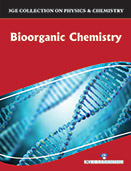Chemistry

Bioorganic chemistry is closely related with the application of the tools of chemistry to the understanding of biochemical processes. Molecular recognition plays an important role in biological systems and is observed in between receptor-ligand, antigen antibody, DNA-protein, sugar-lectin, RNA-ribosome, etc. An important example of molecular recognition is the antibiotic vancomycin that selectively binds with the peptides with terminal D-alanyl-D-alanine in bacterial cells through five hydrogen bonds. The vancomycin is lethal to the bacteria since once it has bound to these particular peptides they are unable to be used to construct the bacteria‘s cell wall. Therefore, the composite term, biophysical organic chemistry, has been used as a detailed descriptor in molecular recognition. Such an understanding is frequently achieved with the aid of molecular models chemically synthesized in the laboratory. This permits a "sorting out" of the many variable parameters simultaneously operative within the biological system. For example, how does a biological membrane work? One builds a simple model of known compositions and studies a single behavior, such as an ion transport property. How does the brain work? This is by far a more complicated system than the previous example. Again one studies single synapses and single synaptic constituents and then uses the observations to construct a model.
This volume entitled with “Bioorganic Chemistry” is intend for non-chemistry students, primarily those entering health sciences and related fields, such as medicine, dentistry. It also can be useful for students in environmental studies. Most students who take such courses consider bioorganic chemistry to be the most relevant part of the course of study. However, an understanding of bioorganic chemistry depends upon a sound background in organic chemistry. This book presents organic chemistry in sufficient to make the bioorganic chemistry understandable. The book addresses biological questions at the molecular level, using organic chemistry and principles of physical organic chemistry.
All living processes require energy, which is obtained by performing chemical reactions inside cells. These biochemical processes are based on chemical dynamics and involve reductions and oxidations. Biological oxidations are thus the main source of energy to drive a number of endergonic biological transformations. Many of the reactions include burn of foods such as sugars and lipids in result to create energy that is utilized for a variety of essential functions such as growth, replication, maintenance, muscular work, and heat production. These transformations are also related to oxygen uptake; breathing is a biochemical process by which molecular oxygen is reduced to water. Throughout these pathways, energy is stored in the form of adenosine triphosphate (ATP), an energy-rich compound known as the universal product of energetic transactions.
This book will be primer for all — students and researchers alike — seeking orientation in this fascinating field of chemistry.